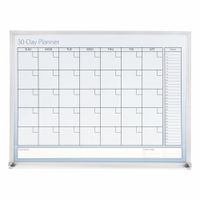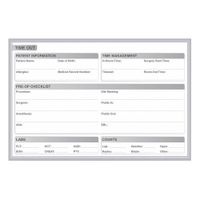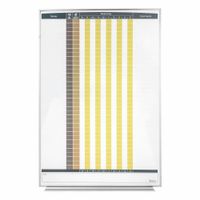Call +(254) 703 030 000 / 751 483 999 / 721 704 777
- Home
- Office Supplies
- Boards Easels
- Dry Erase Boards Sheets
- Specific Use Dry Erase Boards
.....Read More
Frequently Asked Questions
What are the benefits of using pre-printed dry-erase boards in the workplace?
Pre-printed dry-erase boards offer several benefits in the workplace:
1. **Organization and Structure**: They provide a structured format for information, which helps in organizing thoughts and data efficiently. This is particularly useful for project management, scheduling, and tracking progress.
2. **Time-Saving**: With pre-printed templates, employees save time as they don't need to draw grids, charts, or tables manually. This allows for quick updates and modifications.
3. **Consistency**: Standardized layouts ensure consistency across different teams and departments, making it easier to understand and interpret information at a glance.
4. **Enhanced Communication**: These boards facilitate clear communication by providing a visual representation of data, which can be easily understood by all team members, thus reducing misunderstandings.
5. **Increased Productivity**: By streamlining processes and reducing the time spent on setting up presentations or meetings, employees can focus more on their core tasks, thereby boosting productivity.
6. **Flexibility**: While they provide a structured format, pre-printed boards still allow for flexibility in terms of content, as they can be easily erased and updated as needed.
7. **Professional Appearance**: They offer a neat and professional look, which is beneficial for client meetings or presentations, enhancing the company’s image.
8. **Cost-Effective**: Over time, they reduce the need for paper and printing, contributing to cost savings and environmental sustainability.
9. **Engagement**: Visual tools like these can increase engagement during meetings, as they make it easier for participants to follow along and contribute.
10. **Customization**: Many pre-printed boards can be customized to fit specific business needs, ensuring that they are relevant and useful for particular tasks or projects.
How do grid dry-erase boards assist in graphing and charting tasks?
Grid dry-erase boards assist in graphing and charting tasks by providing a pre-structured surface that simplifies the plotting of data points and the drawing of lines or curves. The grid pattern, typically composed of evenly spaced horizontal and vertical lines, acts as a guide for accurate placement and alignment, ensuring precision in the representation of data. This is particularly useful for creating graphs such as bar charts, line graphs, and scatter plots, where spatial accuracy is crucial.
The erasable nature of these boards allows for easy corrections and adjustments, facilitating iterative processes where data may need to be updated or refined. Users can quickly modify graphs without the mess or permanence of traditional paper methods. This flexibility is beneficial in dynamic environments like classrooms or meetings, where real-time data analysis and discussion occur.
Additionally, grid dry-erase boards support collaborative work. Multiple users can contribute to the graphing process simultaneously, making them ideal for group projects or brainstorming sessions. The boards can be used repeatedly, making them a cost-effective and environmentally friendly option compared to paper-based alternatives.
The visual clarity provided by the grid lines enhances the readability of graphs and charts, aiding in the communication of complex data. This clarity is essential for presentations, where the audience needs to quickly grasp the information being conveyed.
Overall, grid dry-erase boards streamline the graphing and charting process by offering a reusable, precise, and collaborative platform, enhancing both the efficiency and effectiveness of data visualization tasks.
What features should I look for in a calendar dry-erase board?
1. **Size and Space**: Choose a board that fits your wall space and provides enough room for writing. Consider the number of people using it and the amount of information you need to display.
2. **Material Quality**: Opt for a board with a durable surface, such as porcelain or tempered glass, which resists staining and ghosting. Melamine boards are more affordable but may wear out faster.
3. **Grid Layout**: Ensure the calendar grid is clear and easy to read, with enough space in each day box for notes. Some boards offer customizable grids for flexibility.
4. **Magnetic Surface**: A magnetic board allows you to attach notes, photos, or important documents with magnets, adding functionality.
5. **Mounting Options**: Check for easy and secure mounting options. Some boards come with wall-mounting kits or can be used on easels.
6. **Accessories**: Look for boards that include essential accessories like markers, an eraser, and magnets. Some may have built-in marker trays or pen holders.
7. **Design and Aesthetics**: Choose a design that complements your space, whether it's a sleek modern look or a classic style. Frame options can range from metal to wood.
8. **Ease of Cleaning**: Ensure the board is easy to clean without leaving residue. High-quality surfaces require less maintenance.
9. **Durability**: Consider the board's longevity, especially if it will be used frequently. Higher-end materials tend to last longer.
10. **Price**: Balance your budget with the features you need. While higher-quality boards may cost more, they often offer better durability and functionality.
11. **Brand Reputation**: Research brands known for quality and customer satisfaction to ensure a reliable product.
How can In/Out dry-erase boards improve office communication and attendance tracking?
In/Out dry-erase boards enhance office communication and attendance tracking by providing a clear, visual representation of employee availability. These boards allow staff to quickly update their status, indicating whether they are in the office, out for meetings, or working remotely. This real-time information fosters efficient communication by enabling colleagues to know who is available for collaboration or immediate consultation, thus reducing time spent searching for team members.
Moreover, In/Out boards streamline attendance tracking by offering a straightforward method for recording presence. Managers can easily monitor attendance patterns, identify trends, and address any issues related to punctuality or absenteeism. This visibility aids in resource planning and ensures that adequate staffing levels are maintained to meet operational demands.
The boards also promote accountability, as employees are responsible for updating their status, encouraging punctuality and transparency. This can lead to a more disciplined work environment where staff are more conscious of their time management.
Additionally, In/Out boards can be customized to include additional information such as contact details or expected return times, further enhancing communication. They serve as a centralized hub for information, reducing the need for multiple communication channels and minimizing the risk of miscommunication.
Overall, In/Out dry-erase boards are a cost-effective tool that supports efficient office operations by improving visibility, enhancing communication, and simplifying attendance tracking.
What are continuous improvement dry-erase boards, and how do they enhance workplace efficiency?
Continuous improvement dry-erase boards are visual management tools used in workplaces to facilitate ongoing enhancements in processes, productivity, and efficiency. These boards are typically placed in accessible locations within a workplace, allowing team members to easily view, update, and discuss information related to continuous improvement initiatives.
The boards often include sections for tracking key performance indicators (KPIs), listing improvement ideas, documenting progress on current projects, and highlighting any issues or obstacles. They may also feature areas for daily or weekly goals, action plans, and feedback from team members. By providing a centralized location for this information, continuous improvement boards help ensure that everyone is aligned and focused on the same objectives.
These boards enhance workplace efficiency in several ways:
1. **Visibility and Transparency**: They make information readily available to all team members, promoting transparency and ensuring everyone is aware of current priorities and progress.
2. **Collaboration and Communication**: By serving as a focal point for discussions, these boards encourage collaboration and open communication among team members, fostering a culture of shared responsibility and teamwork.
3. **Accountability**: With clear documentation of tasks and responsibilities, team members are more likely to take ownership of their roles and be accountable for their contributions to improvement efforts.
4. **Problem-Solving**: The boards provide a platform for identifying and addressing issues quickly, enabling teams to implement solutions and prevent problems from escalating.
5. **Continuous Feedback**: Regular updates and reviews of the board's content allow for continuous feedback and iterative improvements, helping teams to adapt and refine processes over time.
Overall, continuous improvement dry-erase boards are effective tools for driving efficiency by promoting a culture of ongoing improvement, enhancing communication, and ensuring alignment across teams.
How do healthcare dry-erase boards support medical staff in patient care management?
Healthcare dry-erase boards support medical staff in patient care management by enhancing communication, organization, and efficiency. They serve as a centralized hub for critical patient information, allowing for quick updates and easy access to data. This ensures that all team members, including doctors, nurses, and support staff, are on the same page regarding patient status, treatment plans, and daily goals.
These boards facilitate real-time communication, reducing the likelihood of errors and miscommunication. By displaying vital information such as patient names, room numbers, allergies, and scheduled procedures, they help in streamlining workflow and prioritizing tasks. This visibility aids in coordinating care among multidisciplinary teams, ensuring that everyone is aware of their responsibilities and deadlines.
Moreover, dry-erase boards can be customized to include checklists and reminders for medication administration, vital sign monitoring, and other routine tasks, promoting adherence to protocols and improving patient safety. They also provide a platform for tracking patient progress, enabling staff to quickly assess changes in condition and adjust care plans accordingly.
In addition to supporting staff, these boards can enhance patient engagement by involving them in their care. Patients and families can view and understand the care plan, ask informed questions, and provide input, fostering a collaborative environment.
Overall, healthcare dry-erase boards are a versatile tool that improves the quality of care by ensuring clear communication, efficient task management, and active patient participation.
What are the best practices for maintaining and cleaning pre-printed dry-erase boards?
1. **Regular Cleaning**: Wipe the board with a dry cloth or eraser after each use to prevent ink from setting. For deeper cleaning, use a damp cloth with a mild detergent.
2. **Avoid Abrasive Materials**: Use soft cloths or microfiber towels to clean the board. Avoid paper towels or rough materials that can scratch the surface.
3. **Use Appropriate Cleaners**: Use cleaners specifically designed for dry-erase boards. Avoid harsh chemicals like ammonia or bleach that can damage the board.
4. **Remove Stubborn Stains**: For ghosting or stubborn marks, use a whiteboard cleaner or a mixture of water and isopropyl alcohol. Apply with a soft cloth and wipe gently.
5. **Condition the Board**: Occasionally apply a thin layer of whiteboard conditioner to maintain the board’s surface and prevent ghosting.
6. **Use Quality Markers**: Use high-quality, low-odor dry-erase markers. Avoid permanent markers or pens that can stain the board.
7. **Test New Markers**: Before using new markers, test them on a small, inconspicuous area to ensure they erase easily.
8. **Avoid Excessive Pressure**: Write gently to prevent indentations or damage to the board’s surface.
9. **Store Markers Properly**: Store markers horizontally to prevent them from drying out and ensure even ink flow.
10. **Check for Damage**: Regularly inspect the board for scratches or damage. Address any issues promptly to prevent further deterioration.
11. **Protect from Sunlight**: Keep the board away from direct sunlight to prevent fading or warping.
12. **Use Magnetic Accessories**: If the board is magnetic, use magnetic accessories to avoid adhesive residues from tape or stickers.




